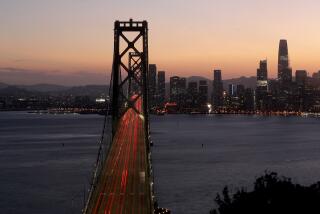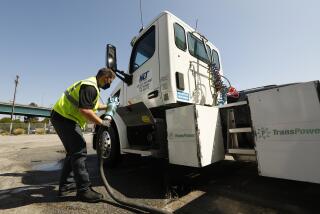Editorial: To save the planet from climate change, gas guzzlers have to die

The numbers paint a daunting picture. In 2019, consumers worldwide bought 64 million new personal cars and 27 million new commercial motor vehicles, a paltry 2.1 million of which were electric-powered. Climate scientists tell us that we have less than a decade to make meaningful reductions in carbon emissions — including those from internal combustion engines — if we have any hope of staving off the worst effects of global warming.
Yet manufacturers are still making, and consumers are still buying, overwhelming numbers of vehicles that will, on average, continue to spew carbon into the atmosphere for a dozen years after they first leave the lot. That means new cars bought this year will still be on the road well into the 2030s — long after the point when we should have slashed emissions.
Like we said, a daunting picture.
What will it take to throttle back the gas burners and expand exponentially the number of vehicles that run on electric batteries, hydrogen fuel cells or other non-fossil energy sources? Political will, strong government thumbs on the scale to favor zero-emission vehicles over gas burners (an all-out ban on their production and sale is likely too radical for the world, but it would certainly help), and increased spending on developing and producing clean energy sources, battery technologies and charging capabilities.
It will also require a significant overhaul of electric grids as we move more quickly from fossil-fueled production of electricity to renewable sources, a process that demands significant investments and research into storage technologies to keep the system working through dark nights and windless days. We will need innovations to speed up car battery charging — or even reduce batteries’ size and cost so that they can be swapped out for a fresh one rather than waiting for a charge to finish, much as we do with propane tanks for gas grills (which we also need to evolve away from).
Such a switch will have its biggest impacts in the U.S. — particularly car-heavy California, where transportation accounts for 47% of the state’s greenhouse gas emissions. Globally, transportation is responsible for only 15% of overall emissions; the main culprit is energy production, including onsite burning of fossil fuels by industries, which accounts for nearly half. Such disparities in the sources of carbon emissions spotlight why an array of global policies are necessary. No single solution will get us to where we need to be.
Still, ending reliance on fossil fuel to power engines will be crucial, and among the most challenging tasks given how deeply insinuated such vehicles have become in global commerce and transit systems, from the personal vehicles we use to fetch groceries to the vessels that move products around the world to the airplanes that take a few hours to shuttle people to places that used to take days or weeks to reach by train or ship.
In a sign of hope, the world seems to be making the move to zero-emission vehicles, albeit slowly. At least a dozen nations and a handful of cities and regional governments — including California’s — have pledged to ban sales of conventional gas-powered vehicles, eight of them by 2030 and the rest by 2040. China, the largest global market for passenger cars, has said it will require most new vehicles sold as of 2035 to be zero-emission. That has led some automakers themselves, most notably GM, to announce fleet-wide commitments to zero-emissions light-duty vehicles.
Much more needs to be done, though, beginning with policies and programs for getting rid of the gas burners already on the road. A disturbingly high number of used vehicles wind up getting exported from the U.S., Europe and Japan to developing nations, where few regulations may govern safety and emissions. While those countries’ need for transportation is clear, it makes little sense to meet that demand with vehicles that will continue contributing to a global emissions problem, and that in many cases wouldn’t pass safety inspections in their exporting countries.
Yes, a daunting picture. But we can’t ignore it. Humankind’s ability to create and use technology got us into this mess, and it will require our collective skills and wills to get us out of it — or at least to minimize the effects of global warming by slashing carbon emissions, developing viable ways to sequester carbon already in the atmosphere and adopting mitigation efforts to counter rising sea levels, worsening floods and droughts, and mass migrations of people already in desperate straits from the effects of extreme weather.
More to Read
A cure for the common opinion
Get thought-provoking perspectives with our weekly newsletter.
You may occasionally receive promotional content from the Los Angeles Times.






